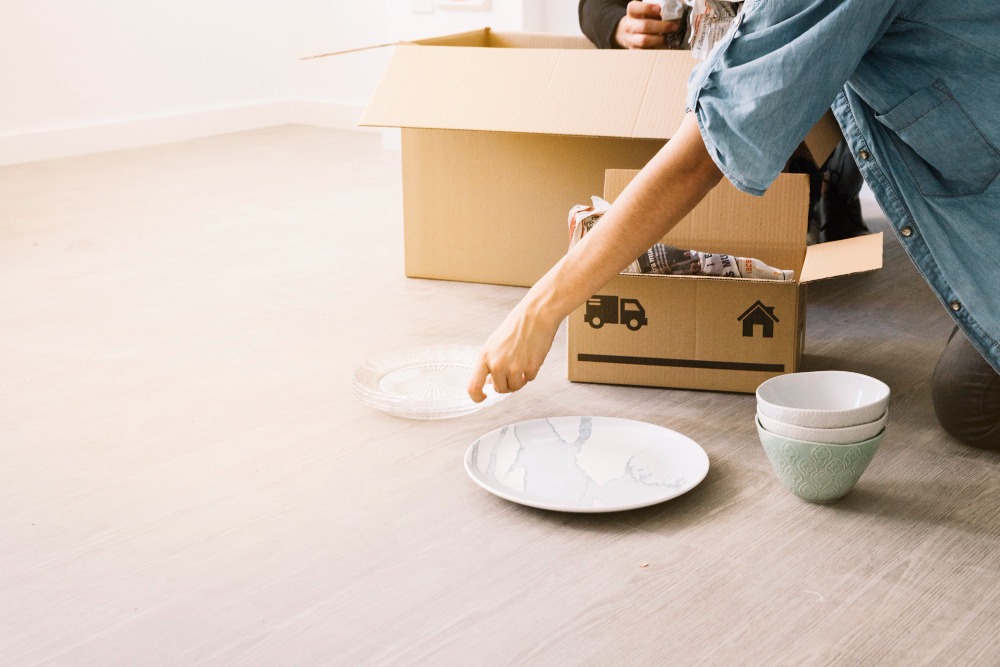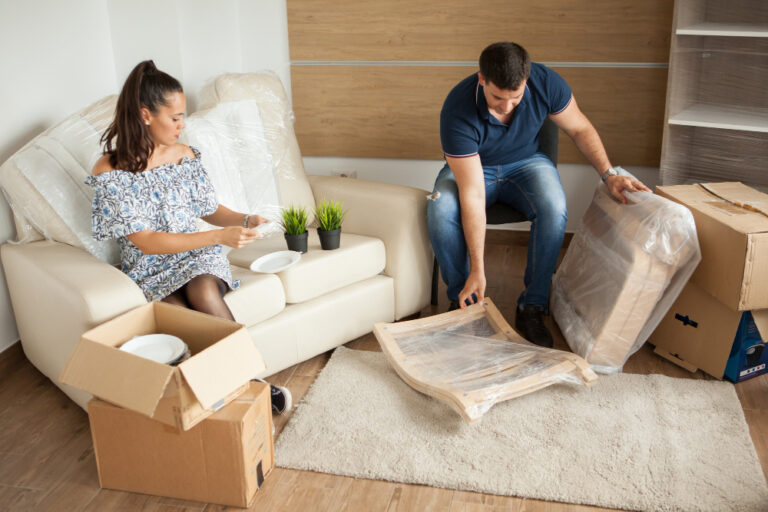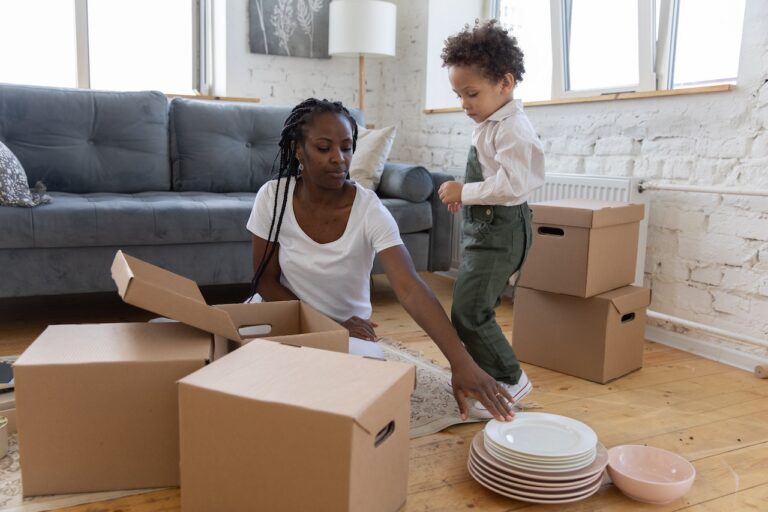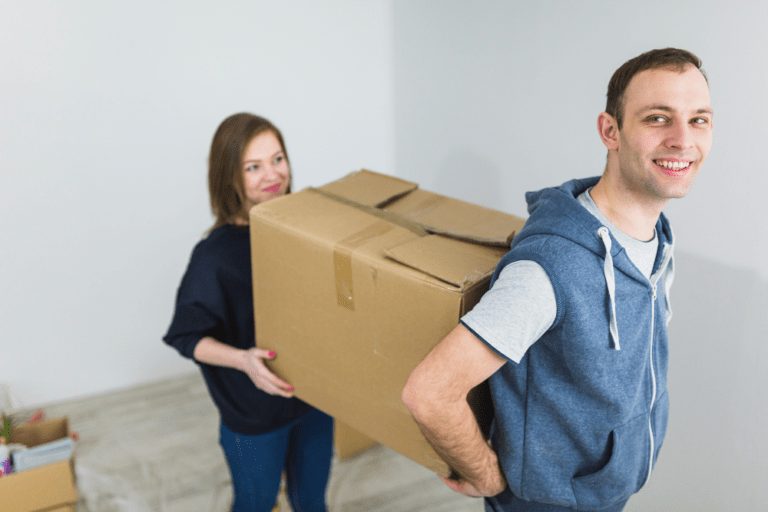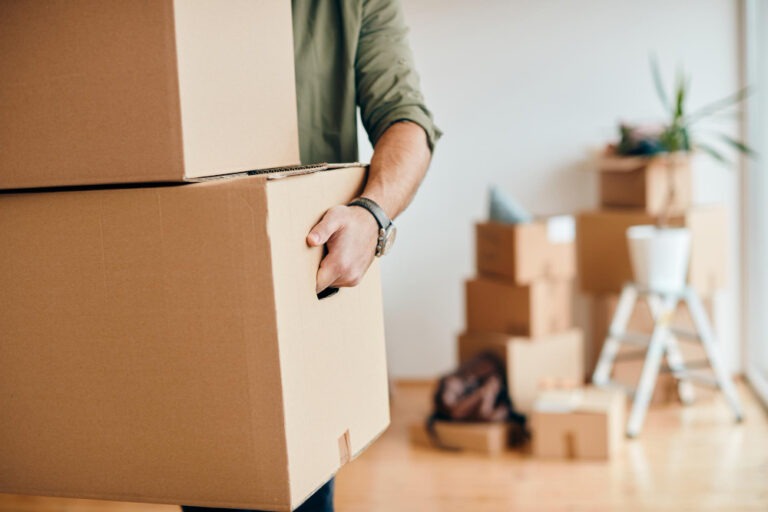Moving homes often brings with it the challenge of ensuring our cherished belongings, especially fragile items like dishes, are transported without damage. Proper packing is paramount, and while many resort to using paper as a cushioning agent, it’s not always the best choice.
Newspapers can leave ink stains, and excessive paper usage isn’t environmentally friendly. Moreover, there are more effective alternatives that offer better protection for your dishes.
Friends Moving, with its 15 years of experience in the moving industry, understands the intricacies of packing and always emphasizes the importance of doing it right. As advocates for sustainable and efficient moving solutions, we’re here to guide you on how to pack your dishes without relying on paper.
Why Avoid Using Paper?
When it comes to packing dishes for a move, paper might seem like the go-to solution. However, there are several reasons why one might reconsider this choice. From environmental implications to practical concerns, let’s delve into why paper might not be the best option for packing your precious dishes.
- Environmental Impact: Using excessive paper contributes to waste, which isn’t environmentally friendly. Opting for reusable packing materials promotes sustainability.
- Ink Transfer: Newspapers, a common packing choice, can leave unsightly ink stains on dishes, requiring additional cleaning post-move.
- Durability Concerns: Paper doesn’t offer the same level of cushioning and protection as some other materials, increasing the risk of breakage.
- Cost Implications: While paper might seem cheap, the potential damage to dishes and the need for replacements can be costly.
- Space Consumption: Bulky paper takes up more space in boxes, reducing the efficiency of packing.
- Better Alternatives: There are numerous other packing materials that are more effective and cost-efficient than paper, making it worthwhile to explore other options.
By understanding these concerns, one can make informed decisions about the best packing materials for their dishes, ensuring safety and sustainability.
Materials You Will Need
Packing dishes without paper doesn’t mean compromising on safety. In fact, with the right materials, you can ensure your dishes are even more secure during the move. Let’s explore the essential items you’ll need to pack your dishes efficiently and sustainably.
- Bubble Wrap or Foam Sheets: These provide superior cushioning for fragile items. They can be wrapped around individual dishes or used as layers between stacked items to prevent chipping or breaking.
- Towels, Blankets, or Old T-Shirts: Not only are these soft and protective, but they’re also reusable. They can be wrapped around dishes or used to fill gaps in boxes, offering added cushioning.
- Sturdy Boxes: It’s crucial to have strong, durable boxes that can handle the weight of dishes without collapsing or tearing.
- Packing Tape: This ensures your boxes are securely sealed. A good-quality tape will prevent boxes from opening during transit.
- Scissors: A necessary tool for cutting bubble wrap, foam sheets, or tape to the desired size.
- Permanent Marker: Essential for labeling boxes. Clearly marking boxes with “Fragile” or indicating their contents can help movers handle them with extra care.
With these materials on hand, you’re well-equipped to pack your dishes in a way that’s both safe and environmentally conscious.
Read More: How to choose the best moving company in Very Beach
8 Effective Ways to Pack Dishes for Moving Without Paper
In the quest for sustainable and efficient moving solutions, it’s essential to explore alternatives to traditional packing methods. Dishes, being some of the most fragile items during a move, require special attention.
While paper has been a go-to for many, there are several other materials that offer better protection and are environmentally friendly. Let’s dive into eight effective ways to pack your dishes without resorting to paper.
1. Bubble Wrap
With its unique air-filled pockets, bubble wrap is a favorite among packing professionals and DIY movers alike. Its design is specifically intended to absorb shocks and protect fragile items from impacts. When wrapping dishes in bubble wrap, it’s essential to ensure that the entire item is covered, with special attention given to edges and corners.
The wrap can be secured with tape, and for added protection, multiple layers can be used. This method is especially beneficial for items like wine glasses or other delicate dishes that have protruding parts.
2. Towels or Blanket
Using towels or blankets is an eco-friendly way to pack dishes since it repurposes items you already own. Thick towels or blankets can be laid at the bottom of a box to create a cushioned base.
Dishes can then be wrapped individually in these materials, ensuring they are cocooned and protected from all sides. This method is particularly useful for larger dishes like platters or bowls that might not fit in standard packing materials.
3. Foam Sheets or Pouches
Foam sheets are versatile packing materials that can be cut and shaped according to the size of the dish. They provide a soft barrier against scratches and can be used to wrap individual items or layered between dishes.
Foam pouches, on the other hand, are pre-made pockets that dishes can be slid into, offering protection on all sides. They are especially useful for standard-sized plates or bowls.
4. Old T-Shirts or Clothing
Repurposing old clothing is not only sustainable but also cost-effective. Soft fabrics, like cotton t-shirts, can be wrapped around dishes, ensuring a snug fit.
They can also be rolled up and placed in gaps within boxes to prevent dishes from moving during transit. This method is especially useful for oddly shaped items that might not fit in standard packing materials.
5. Corrugated Cardboard Dividers
These dividers are designed to compartmentalize boxes, ensuring each dish has its own designated space. By preventing dishes from touching each other, the risk of chipping or scratching is significantly reduced.
These dividers can be purchased or DIYed using old cardboard boxes. They are especially useful for sets of plates, glasses, or bowls that are of similar size.
6. Silicone Dish Protectors
These modern innovations are designed to be placed between dishes, especially plates. Made of soft, flexible silicone, they prevent dishes from rubbing against each other, eliminating the risk of scratches.
They are washable and reusable, making them an eco-friendly choice. Their non-slip surface also ensures dishes remain in place during transit.
7. Air Pillows or Inflatable Packaging
These are essentially pockets of air sealed within the plastic. They are lightweight yet offer excellent cushioning. By filling voids within boxes, they prevent dishes from shifting.
They distribute pressure evenly, ensuring that in case of an impact, the force isn’t concentrated on one spot, reducing the risk of breakage.
8. Reusable Plastic Containers
These containers are sturdy and provide a rigid casing for dishes. They can be filled with other protective materials like bubble wrap or foam sheets for added protection.
Their stackable design ensures efficient use of space in moving trucks. They also have the added benefit of being waterproof, ensuring dishes remain safe even in adverse conditions.
By understanding the benefits and applications of each of these packing materials, movers can make informed decisions, ensuring their dishes reach their destination in pristine condition.
Step-by-Step Guide to Packing Dishes Without Paper
Packing dishes is often seen as one of the most daunting tasks when moving. The fragility of dishes combined with the bumps and jostles of transit can be a recipe for disaster if not done correctly.
However, with the right techniques and materials, you can ensure your dishes arrive at their new home in perfect condition. Here’s a comprehensive guide to packing your dishes without using paper:
1. Preparing the Box
Before you even begin packing your dishes, the box itself needs to be prepped.
- Reinforcing the Bottom: Start by using strong packing tape to reinforce the bottom of the box. This ensures that the box can handle the weight of the dishes without giving way.
- Adding a Cushioning Layer: Lay down a thick layer of towels or bubble wrap at the bottom of the box. This acts as a protective cushion, absorbing any shocks during transit.
2. Packing Plates
Plates are flat but can be surprisingly fragile, especially around the edges.
- Vertical Placement: Instead of stacking plates flat, place them vertically in the box. This reduces the pressure on individual plates and minimizes the risk of breakage.
- Wrapping: Wrap each plate individually in a towel or foam sheet, ensuring all parts of the plate are covered.
- Cushioning: After every few plates, add an additional layer of bubble wrap or towels for extra protection.
3. Packing Bowls
Bowls can be tricky due to their varied sizes and shapes.
- Nesting: Where possible, place smaller bowls inside larger ones but ensure they’re wrapped to prevent direct contact.
- Wrapping: Like plates, wrap each set of nested bowls in a towel or foam sheet to provide a protective barrier.
4. Packing Glasses and Cups
These items are particularly vulnerable due to their hollow nature and thin walls.
- Internal Cushioning: Fill the inside of each glass or cup with crumpled towels or foam to provide internal support.
- External Wrapping: Wrap the entire exterior of the glass or cup, paying special attention to handles or protruding designs.
5. Packing Specialty Dishes
Items like wine glasses or serving platters often require special attention due to their unique shapes and designs.
- Extra Cushioning: Given their fragility, these items benefit from multiple layers of protective material, whether it’s bubble wrap, foam sheets, or towels.
- Secure Placement: Ensure that these items are snugly placed in the box, with no room to move or jostle. Use additional cushioning materials to fill any gaps.
6. Sealing and Labeling the Box
The final step ensures that your efforts in packing are not in vain.
- No Empty Spaces: Before sealing the box, make sure there are no empty spaces. Fill gaps with towels, foam, or air pillows to ensure items don’t shift during transit.
- Labeling: Clearly label boxes with their contents. Marking boxes as “Fragile” alerts movers to handle them with extra care.
By following this step-by-step guide, you can be confident that your dishes are packed securely, ready to make the journey to their new home without any mishaps.
Benefits of Using Alternative Packing Materials
In the realm of moving and packing, the materials you choose play a pivotal role in ensuring the safety of your belongings. Traditional packing materials like paper, while commonly used, may not always be the most effective or environmentally friendly option.
By opting for alternative packing materials, you not only ensure the safety of your items but also embrace a more sustainable approach. Household items like towels, for instance, offer the dual benefit of cushioning and reusability. Once you’ve settled into your new home, these items can easily be repurposed for their original use, eliminating the need for disposal.
Furthermore, materials like bubble wrap or foam sheets often provide superior protection compared to paper, safeguarding your dishes from potential breakages. In the broader perspective, by choosing alternatives to paper, you’re taking a step towards sustainability, reducing waste, and minimizing the environmental impact of your move.
Choose Friends Moving for a Smooth and Stress-Free Relocation
Embarking on a relocation journey can be daunting, but with the right moving company by your side, the process becomes significantly smoother. Here’s why choosing Friends Moving is the best decision for your move:
- Experience: With years in the industry, we’ve honed our skills to perfection.
- Professionalism: Our team is trained to handle all items, especially fragile ones, with utmost care.
- Sustainability: We advocate for eco-friendly packing methods, reducing environmental impact.
- Affordability: Quality service doesn’t have to break the bank with Friends Moving.
- Reliability: We guarantee timely and safe delivery of all your belongings.
- Customer Satisfaction: Our primary goal is to ensure our clients are happy and stress-free during their move.
Read More: Office relocation tips in Vero Beach
Conclusion
The process of moving is more than just a physical transition; it’s about ensuring the safety and integrity of cherished belongings, especially fragile items like dishes. As we’ve explored, the materials and methods you choose for packing can make a significant difference in both the safety of your items and the environmental footprint of your move.
Embracing sustainable and effective packing methods safeguards your dishes and contributes to a greener planet. As you embark on this journey, remember that you don’t have to do it alone.
Contact Friends Moving to ensure a smooth, efficient, and stress-free relocation, making your transition to a new home a pleasant experience.
FAQs
The best alternatives to paper for packing dishes include bubble wrap, foam sheets, towels, blankets, old t-shirts, corrugated cardboard dividers, silicone dish protectors, and reusable plastic containers.
It’s advisable to start packing non-essential items at least three to four weeks before your move. For essential items, such as daily-use dishes, you can pack them a few days before the move.
Absolutely! Many packing materials, especially alternatives to paper like bubble wrap, foam sheets, and reusable plastic containers, can be stored and reused for future moves. This not only saves money but is also environmentally friendly.
To ensure the safety of your dishes, wrap each item individually using protective materials like bubble wrap or towels. Place dishes vertically in the box, use dividers for added protection, and fill any gaps with cushioning materials to prevent movement.
Yes, Friends Moving offers comprehensive packing services tailored to your needs. We can provide full or partial packing services and offer a range of high-quality packing materials to ensure the safety of your belongings during transit.
